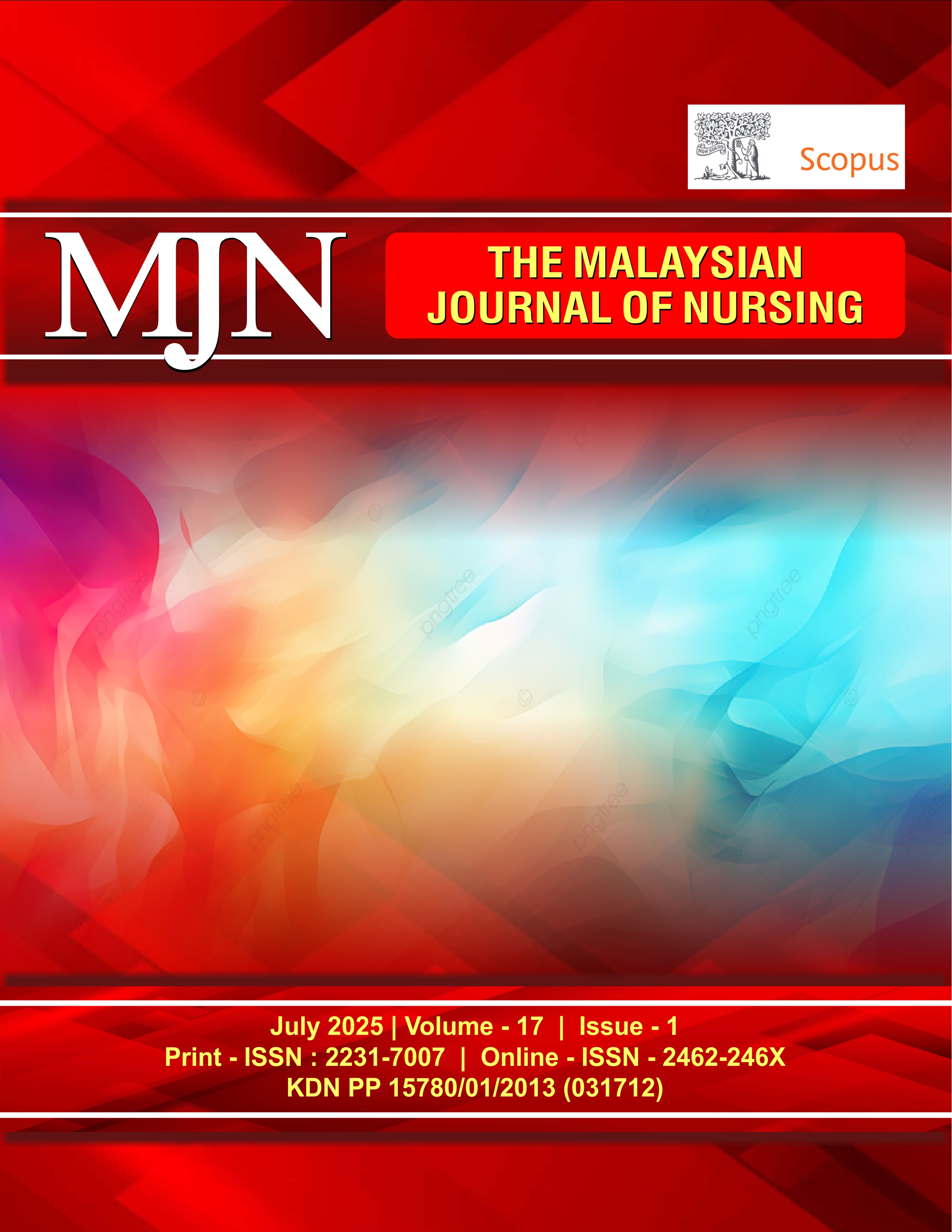Strengthening Nursing SBAR Communication Compliance to Improve Patient Safety
DOI:
https://doi.org/10.31674/mjn.2025.v17i01.009Abstract
Background: Medication errors and patient falls are a significant part of patient safety events, it is estimated that more than 50% of patient injuries in healthcare settings are preventable, mainly due to communication errors. Objectives: The aim of this study was to assess the correlation between nurses' compliance in using SBAR (Situation, Background, Assessment, and Recommendation) communication and patient safety in hospitals. Methods: A descriptive correlational quantitative study was conducted in a regional public hospital. With total sampling, 257 nurses in the paediatric and adult wards, Intensive Care Unit (ICU) and Paediatric Intensive Care Unit (PICU), and Neonatal Intensive Care Unit (NICU) completed a compliance checklist on the implementation of SBAR communication and a summed rating scale regarding patient safety consisting of 20 questions, which were analysed by chi-square statistical test and logistic regression. Results: 257 nurses participated, with a gender distribution of 45.5% male and 54.5% female, and the majority aged 23-33 years (39.3%). Bivariate analysis showed a significant association between SBAR adherence and patient safety, with odds ratios (OR) for each component as follows: Situation (OR 3.230, p<0.001), Background (OR 2.961, p<0.001), Assessment (OR 4.350, p=0.002), and Recommendation (OR 5.018, p=0.001). Multivariate analysis showed that adherence to SBAR significantly improved patient safety, with an overall Omnibus value of 0.000 and a variance explained of 75.60%. Conclusion: The findings of this study showed a significant positive association between adherence to the SBAR (Situation, Background, Assessment, Recommendation) communication framework and better patient safety outcomes among nurses.
Keywords:
Nursing Communication, Patient Safety, SBAR CommunicationDownloads
References
Adam, M. H., Ali, H. A., Koko, A., Ibrahim, M. F., Omar, R. S., Mahmoud, D. S., ... & Habib, K. (2022). The Use of the Situation, Background, Assessment, and Recommendation (SBAR) Form as a Tool for Handoff Communication in the Pediatrics Department in a Sudanese Teaching Hospital. Cureus, 14(11). https://doi.org/10.7759/cureus.31998
Adu, G., & Zuma, S. M. (2024). Contributory factors related to patient safety incidence: A nursing perspective. Health SA = Gesondheid, 29. https://doi.org/10.4102/hsag.v29i0.2296
Alquwez, N. (2020). Examining the influence of workplace incivility on nurses’ patient safety competence. Journal of Nursing Scholarship, 3(52), 292-300. https://doi.org/10.1111/jnu.12553
Ayub, F., Afzal, N., Ali, W., Asif, F., ul Hassan, S. S., Haque, G., Ahmed, F. A., Ajani, K., Tharani, Z., Jaffer, M., Haider, A. H., Aboumatar, H. J., & Latif, A. (2024). Exploring medical and nursing students’ perceptions about a patient safety course: a qualitative study. BMC Medical Education, 24(1). https://doi.org/10.1186/s12909-024-05348-8
Azzellino, G., Dante, A., Petrucci, C., Caponnetto, V., Aitella, E., Lancia, L., Ginaldi, L., & De Martinis, M. (2025). Intention to leave and missed nursing care: A scoping review. International Journal of Nursing Studies Advances, 8. https://doi.org/10.1016/j.ijnsa.2025.100312
Daheshi, N., Alkubati, S. A., Villagracia, H., Pasay-an, E., Alharbi, G., Alshammari, F., Madkhali, N., & Alshammari, B. (2023). Nurses’ perception regarding the quality of communication between nurses and physicians in emergency departments in Saudi Arabia: A Cross-Sectional Study. Healthcare, 11(5). https://doi.org/10.3390/healthcare11050645
Mulfiyanti, D., & Satriana, A. (2022). The correlation between the use of the SBAR effective communication method and the handover implementation of nurses on patient safety. International Journal of Public Health Excellence (IJPHE), 2(1), 376-380. https://doi.org/10.55299/ijphe.v2i1.275
Ejupi, V., Squires, A., & Skela-Savič, B. (2025). exploring influential factors shaping nursing as a profession and science in healthcare system—A systematic literature review. Healthcare, 13(6). https://doi.org/10.3390/healthcare13060668
Galatzan, B. J., Johnson, E., Judson, T., & Shan, L. (2024). Linguistic dissection of nursing handoffs: Implications for patient safety in varied‐acuity hospital settings. Journal of Clinical Nursing, 33(8), 3077-3088. https://doi.org/10.1111/jocn.17190
Gani, M. S., Arso, S. P., & Dwiantoro, L. (2023). Factors influencing health worker compliance in implementing patient safety goals in Indonesia: Systematic review. Indonesian Journal of Multidisciplinary Science, 3(2), 102–109. https://doi.org/10.55324/ijoms.v3i2.680
Garza, F. P., Gomes, A. J. F., Rosinhas, A. S. N., Sampaio, F., López, G. M., & Pérez, E. L. (2025). Bedside shift handover in open-box ICUs: Nursing perspectives and challenges from a focus group study. BMC Nursing. https://doi.org/10.21203/rs.3.rs-6136762/v1
Gkentzi, D., Mhliordos, K., Karatza, A., Sinopidis, X., Dimopoulou, D., Eleftheriou, E., Tsolia, M., Mavridi, A., Miliara, E., Papaevangelou, V., Vergadi, E., Galanakis, E., Dimitriou, G., & Fouzas, S. (2022). The Psychological impact of COVID-19 admission on families: Results from a Nationwide Sample in Greece. Children, 9(12). https://doi.org/10.3390/children9121933
Glarcher, M., Kaiser, K., Kutschar, P., & Nestler, N. (2022). Safety climate in hospitals: A cross‐sectional study on the perspectives of nurses and midwives. Journal of Nursing Management, 30(3), 742-749. https://doi.org/10.1111/jonm.13551
Hoffert, M. M., Newman, J., Mortimore, A., Passalacqua, K. D., & Abreu Lanfranco, O. (2024). Explicit training in systematic communication strategies: A pilot study exploring the incorporation of communication tools by first-year residents in simulation and in clinical practice. Journal of Medical Education and Curricular Development, 11. https://doi.org/10.1177/23821205241256042
Howick, J., Bennett-Weston, A., Solomon, J., Nockels, K., Bostock, J., & Keshtkar, L. (2024). How does communication affect patient safety? Protocol for a systematic review and logic model. BMJ Open, 14(5). https://doi.org/10.1136/bmjopen-2024-085312
Irawati, R., Widodo, A., & Yulian, V. (2025). The effective communication using SBAR (Situation, Background, Assessment, Recommendation) of patient handover in inpatient installation. Jurnal Berita Ilmu Keperawatan, 18(1), 47–55. https://doi.org/10.23917/bik.v18i1.6967
Kay, S., Unroe, K. T., Lieb, K. M., Kaehr, E. W., Blackburn, J., Stump, T. E., Evans, R., Klepfer, S., & Carnahan, J. L. (2023). Improving Communication in Nursing Homes Using Plan-Do-Study-Act Cycles of an SBAR Training Program. Journal of Applied Gerontology, 42(2), 194–204. https://doi.org/10.1177/07334648221131469
Krisnawati, K. M. S., Yanti, N. P. E. D., & Rahajeng, I. M. (2023). Implementation of Situation, Background, Assessment, and Recommendation (SBAR) format during handover in the Udayana University Hospital. Nursing and Health Sciences Journal (NHSJ), 3(2), 155–159. https://doi.org/10.53713/nhsj.v3i2.180
Labrague, L. J. (2025). A Systematic Review on Nurse-Physician Collaboration and Its Relationship With Nursing Workforce Outcomes. JONA: The Journal of Nursing Administration, 55(3), 157–164. https://doi.org/10.1097/NNA.0000000000001549
Martínez-Fernández, M. C., Castiñeiras-Martín, S., Liébana-Presa, C., Fernández-Martínez, E., Gomes, L., & Marques-Sanchez, P. (2022). SBAR Method for Improving Well-Being in the Internal Medicine Unit: Quasi-Experimental Research. International Journal of Environmental Research and Public Health, 19(24). https://doi.org/10.3390/ijerph192416813
Mehdi, A. EL, & Lahiala, A. (2025). Enhancing Communication and Patient Safety in Anesthesia Nursing: A Review of the SBAR Method. International Journal of Research and Innovation in Social Science, 9(2), 3720–3731. https://doi.org/10.47772/IJRISS.2025.9020288
Park, Y. H., Lal, S., Lee, J. E., Choi, Y. La, Wen, J., Ram, S., Ding, Y., Lee, S. H., Powell, E., Lee, S. K., Yu, J. H., Ching, K. A., Nam, J. Y., Kim, S. W., Nam, S. J., Kim, J. Y., Cho, S. Y., Park, S., Kim, J., … Kan, Z. (2020). Chemotherapy induces dynamic immune responses in breast cancers that impact treatment outcome. Nature Communications, 11(1). https://doi.org/10.1038/s41467-020-19933-0
Pinto, F., Roberto, P., Ferrario, L., Marotta, L., Montani, D., Auletta, G., ... & Foglia, E. (2025). Using ‘Situation‐Background‐Assessment‐Recommendation’Method in Palliative Care to Enhance Handover Quality and Nursing Practice: A Mix Method Study. Journal of Clinical Nursing, 34(1), 117-127. https://doi.org/10.1111/jocn.17537
Rodrigues, B. B., Moreira, S. G. B. da S., Gondim, M. A. M., Lopez, A. S. Q., Peres, R. de S., Lima, A. R., Morais, Y. R. V., Souza, M. M. S., Duarte, A. C. L., Chaves, G. A. V. B., Silva, R. de S., & Costa, A. M. de O. M. (2025). Effective Communication Between Multiprofessional Health Teams: Practical Strategies to Ensure Patient Safety and Quality of Care. Revista De Gestão Social E Ambiental, 19(4). https://doi.org/10.24857/rgsa.v19n4-022
Ruttmann, K., Albaladejo-Fuertes, S., Lindenberg, N., Kunst, C., Mehrl, A., Kindl, V., Gülow, K., Schlosser-Hupf, S., Schmid, S., & Müller, M. (2024). Relationship between interprofessional collaboration and psychological distress experienced by healthcare professionals during COVID-19: A monocentric cross-sectional study. Frontiers in Medicine, 11. https://doi.org/10.3389/fmed.2024.1292608
Sekanina, U., Tetzlaff, B., Mazur, A., Huckle, T., Kühn, A., Dano, R., Höckelmann, C., Scherer, M., Balzer, K., Köpke, S., Hummers, E., & Müller, C. (2024). Interprofessional collaboration in the home care setting: perspectives of people receiving home care, relatives, nurses, general practitioners, and therapists—results of a qualitative analysis. BMC Primary Care, 25(1). https://doi.org/10.1186/s12875-024-02313-8
Sembiring, M. C., Nasution, S. L. R., & Girsang, E. (2022). The Effect of Sbar Communication on Nurse Attitude in Increasing Patient Safety in Krmt Wongsonegoro Hospital, Semarang. International Journal of Health and Pharmaceutical (IJHP), 2(4), 680-683. https://doi.org/10.51601/ijhp.v2i4.91
Seriga, S., Hassan, H. C., & Sansuwito, T. (2024). Nurses’ knowledge of patient safety incidents: Literature review. International Journal of Health Sciences, 2(1), 336–347. https://doi.org/10.59585/ijhs.v2i1.302
Sezgin, M. G., & Bektas, H. (2023). Effectiveness of interprofessional simulation-based education programs to improve teamwork and communication for students in the healthcare profession: A systematic review and meta-analysis of randomized controlled trials. Nurse Education Today, 120. https://doi.org/10.1016/j.nedt.2022.105619
Shinta, N. D., & Bunga, A. L. (2024). The implementation of SBAR communication method for patient safety: A literature review. Malahayati International Journal of Nursing and Health Science, 7(5). https://doi.org/10.33024/minh.v7i5.190
Soyaslan, B. D., & Öksüz, E. (2025). Examination of Altruism and Compassionate Communication Levels in Nursing Students: A Cross‐Sectional Study. Scandinavian Journal of Caring Sciences, 39(1). https://doi.org/10.1111/scs.70004
Sukesih, S., & Faridah, U. (2020). SBAR Communication (Situation, Background, Assessment, Recomendation) on attitude and nursing behavior in improving patient safety. Jurnal Kesehatan Masyarakat, 16(2), 163–168. Retrieved from https://repository.unar.ac.id/jspui/bitstream/123456789/3692/1/163-168.pdf. Accessed on 15th February 2023.
Terry, D., Hills, D., Bradley, C., & Govan, L. (2024). Nurse‐led clinics in primary health care: A scoping review of contemporary definitions, implementation enablers and barriers and their health impact. Journal of Clinical Nursing, 33(5), 1724–1738. https://doi.org/10.1111/jocn.17003
Toumi, D., Dhouib, W., Zouari, I., Ghadhab, I., Gara, M., & Zoukar, O. (2024). The SBAR tool for communication and patient safety in gynaecology and obstetrics: A Tunisian pilot study. BMC Medical Education, 24(1). https://doi.org/10.1186/s12909-024-05210-x
Tůmová, P., & Bártlová, S. (2023). Transferring patient information using the SBAR communication tool for interpretation. KONTAKT-Journal of Nursing & Social Sciences related to Health & Illness, 25(3). https://doi.org/10.32725/kont.2023.026
Usi, R. Z. F., Kamil, H., Mayasari, P., Jannah, N., & Yusuf, M. Assessment and management of fall risk in the inpatient ward of the Aceh Government Hospital: Case Study. Professional Nurse, 11(47). https://doi.org/10.62225/2583049X.2024.4.2.2460
Wardahni, R. K. (2024). Implementation of effective communication to realize patient safety in emergency installations. World Journal of Advanced Research and Reviews, 21(2), 1241–1246. https://doi.org/10.30574/wjarr.2024.21.2.0550
Wong, K. L., Chua, W. L., Griffiths, P., Goh, Q. L. P., Low, K. W. C., Tan, J. Q. A., & Liaw, S. Y. (2025). Teamwork between registered nurses and unlicensed assistive personnel in acute care settings: A scoping review. International Journal of Nursing Studies Advances, 8. https://doi.org/10.1016/j.ijnsa.2025.100293
World Health Organisation. (2024, March 4). Making older persons visible in the Sustainable Development Goals’ monitoring framework and indicators. Retrieved from: https://www.who.int/publications/i/item/9789240090248. Accessed on 13th February 2023.
Yetti, K., Dewi, N. A., Wigiarti, S. H., & Warashati, D. (2021). Nursing handover in the Indonesian hospital context: Structure, process, and barriers. Belitung Nursing Journal, 7(2), 113–117. https://doi.org/10.33546/bnj.1293
Published
How to Cite
Issue
Section
License
Copyright (c) 2025 The Malaysian Journal of Nursing (MJN)

This work is licensed under a Creative Commons Attribution-NonCommercial-NoDerivatives 4.0 International License.



































